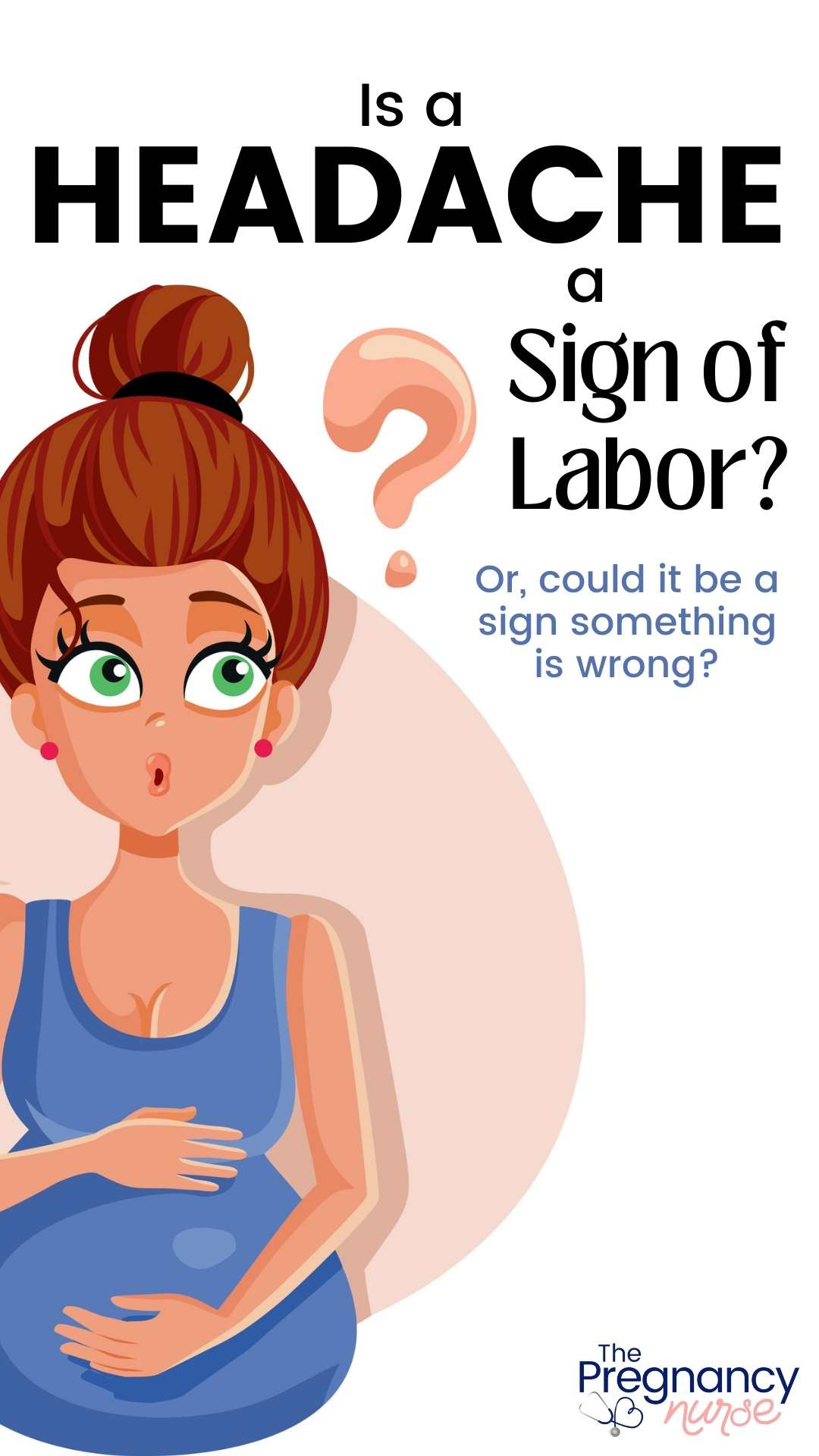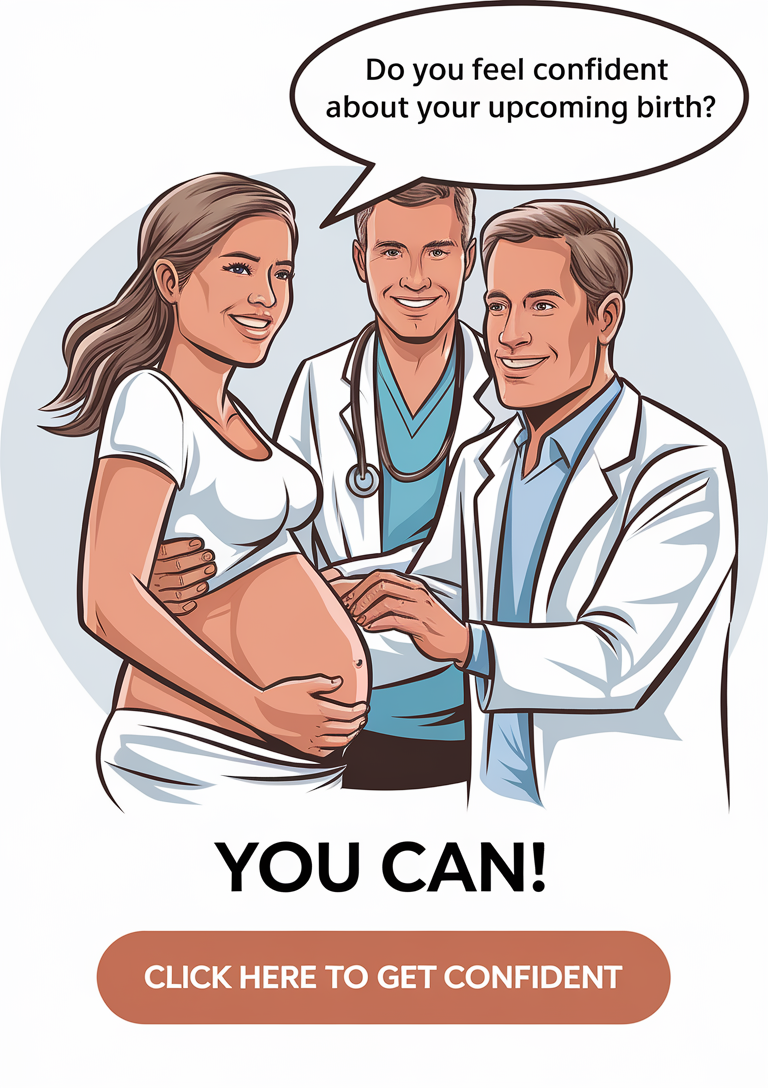Who has headaches in pregnancy {everyone raises their hand}. Is a headache a sign of LABOR? Honestly, not really — but it CAN be a sign of other things, and I want to make SURE you’re trying what you can to get rid of it. So, let’s get started!
Please note that the advice in this article is for someone close to their due date — if you’re before 37 weeks, you’ll want to talk with your provider about these labor signs as they may believe it is too early for you to have your baby (preterm labor), and may want to prevent it to help baby “cook” a bit longer in the womb. It is very different when you’re at the end of your pregnancy.
Before we get started though — why do I know so much about headaches?
Hi — I’m Hilary — The Pregnancy Nurse 👩⚕️. I have been a nurse since 1997 and I have 20 years of OB nursing experience, I am also the curly head behind Pulling Curls and The Online Prenatal Class for Couples. 🩺 I have talked to thousands of people about their headaches in pregnancy, as well as labor signs (and what eventually happened) — so I’m an expert on this one.
Is a headache ever a sign of labor?
A headache can be a sign of labor for pregnant women, but it isn’t one of the main ones that people notice or watch for.
If you are pregnant and experiencing a headache, it is a good idea to consult your health care provider (doctor or midwife) to rule out other potential causes, as a lingering headache can be problematic.
Most people describe it as “generalized malaise” before going into labor. Which means you just don’t feel well. And sometimes that includes a headache. However, headaches are part of pregnancy for a LOT of people…. so that makes it hard.
In here I make it easy to understand though, so come join me!
Headaches can often be a bad sign though…..
Why can a headache be a problem in your third trimester?
Headaches can be a sign of preeclampisa, which is more likely the further along you are and can be really bad for you and the baby.
Other signs of preeclamipsa include:
- Blurry Vision
- Pain under your ribs on the right side
- Lingering headaches that don’t go away with food and water
- Facial swelling
- Increased blood pressure
Of course, all of those can be signs of other things, but because preeclampisa can sometimes be “hiding” in pregnant women, we take them really seriously.
The good news is that your provider can easily take your blood pressure, do some bloodwork and a urine test to see if this is a problem for you.
Preeclampsia isn’t uncommon during pregnancy, but it is serious and needs to be monitored. In some cases you may need to be induced (as the only way to stop it is to get the placenta & baby out of your womb).
They can easily test for it with some lab work:
It can be hard to differentiate between labor signs and something that’s a problem — so grab my labor signs checklist here:
When Does Labor Start?
The vast majority of women go into labor between 37 and 42 weeks of pregnancy.
But, it can really hard to pinpoint when labor starts. You make wake up just feeling worse than you have in the past few days (hard to say since each day of pregnancy seems to feel like this). You’re crampy and just kind of “bleh”. And then you get a few more symptoms (don’t worry, we’re going to talk more about those below) and suddenly as you’re considering going to the hospital you realize that labor “started” a few hours — but kind of without you really knowing it.
I realize that is a VERY confusing answer, but knowing when labor begins can only truly be pinpointed in hindsight — and even then the start of labor can be hard.
What Are The Early Signs and Symptoms of Labor?
There are a few signs of early signs of labor that you can watch for:
Loss of your mucus plug — while this isn’t a “telltale” sign it’s something that a lot of pregnant people notice has happened in the last week (or weeks) of labor. It shows that the cervix is softening (and we’ll talk more about why that is important down below).
Pro Tip: Many people profess that once you lose your mucus plug labor is 24 to 48 hours away but it isn’t a crystal ball and this is just ONE of the signs to watch for — sometimes it re-creates itself and you’re pregnant for a bit longer.
Changes in vaginal discharge — You might notice that things are just more damp down there. You may notice some brown blood that has come out (brown blood means old blood and is less disconcerting than red blood, although you may have small amounts of bright red spotting as your contractions intensify — if it’s more than spotting you’ll want to call your provider).
Pro Tip: Bleeding in labor is often called “bloody show” — so don’t worry if you hear it called that. Even if it’s gross.
Nausea, diarrhea and possibly vomiting — Your gastrointestinal system is just preparing the way for a smooth delivery. And to do that, they just need to clear out those pathways — doing this. You may not feel very hungry either. Totally normal (although try to have a few snacks that balance carbs and proteins to keep up your energy)
Generalized Malaise — A big term for just not feeling so great, like we talked about above. You may experience feeling achy or a small headache (should likely go away with food and water though). Just not feeling so great (some women think they’re getting sick).
Contractions — I saved this one, since most people are only looking for these. Most people feel like early labor feels very similar to period cramps. They may also feel that “pelvic fullness” (or pelvic pressure) that they feel during a period as well. Contractions may be on your belly or in your back due to baby’s positioning. We will talk more in this post about how contractions may vary as you get into “active labor”.
What’s a contraction? Your uterus is actually a big muscle and it contracts that muscle (just like you do when you’re lifting weights) to help expel baby out. Think of it as a big muscle squeezing baby down into the birth canal.
Your bag of waters breaks — Water breaking is a true sign of labor, and one that can also be kind of hard to tell. Many women can’t really tell if they peed a little bit or if it is amniotic fluid (I actually have a “did my water break quiz” on my sister site). The best thing to do if you’re not sure is to put a pad on (a big one) and lay down for a bit, then stand up and see if more water comes out. You can also try to cough or bear down and see if more water comes out as well. And, if you’re in doubt call your provider. They may have a test in the office, or will refer you to the hospital where they can provider a test called Amnisure that can be sure whether or not your water broke. I also have a quiz on my sister site to get you started.
What’s this bag of waters? Remember your baby is living in a bag of waters in your uterus. For some women it breaks while they are at home and a gush of fluid comes out.
While it’s fine to wait a bit of time to decide if your water broke, if you’re still wondering after a few hours, call your provider. Once your water breaks, you have an increased risk of infection, and we don’t need that.
Pro Tip: While first-time moms tend to worry about this more, knowing if it’s the “real thing” can be hard no matter what baby you’re on as every labor can feel very different.
And yes, in here we talk a LOT more about ALL of this!
When to Call Your Healthcare Provider and Go to the Hospital
Make SURE that you ask your provider about what they recommend for YOU at your NEXT appointment. This can vary due to obstetrical history, traffic, how far away you live (and don’t get me started on hospital parking situations). I have a whole post on timing on when to get to the hospital.
That being said, most say contractions at regular intervals of 3-5 minutes that you can’t talk through lasting 30 minutes to an hour (with first baby’s contractions needing to be closer to 3, and moms who’ve already have babies can be a bit further apart).
And, as I said above most providers have someone to take phone calls on for them in the night time (and at the office during the daytime), so making a phone call can put your mind at ease over what to watch for.
Remember the hospital does a lot of labor checks and a good percentage of those people we send home to labor a bit longer in a place they are comfortable. A false alarm isn’t something to be embarrassed about. It’s nice to know that both you and the baby are safe.
In my years of experience most often a headache is normally just a symptom of pregnancy, it is sometimes a symptom of preeclampsia, and not normally a sign of labor.
If you’re 38 weeks pregnant and have a headache, it could be a sign of labor, but a lingering headache should send you into your provider. By paying attention to your body and knowing what’s normal for you, you can help ensure a healthy delivery for both you and your baby! I wish you the very best for the birth of your baby!
And finally — I have to ask: Do you feel prepared for labor? The Online Prenatal Class for Couples really is the easy (and fun) way to get prepared for birth together — come join me!
Want to do a vibe check before diving into the whole thing with me? — check out my free labor pro tips. It’s your first step toward getting in the driver’s seat of your birth.
Don’t miss my super helpful post all about the signs of labor. Great info for pregnancy!










 What are Birthing Classes And What You Can Expect with Childbirth Education
What are Birthing Classes And What You Can Expect with Childbirth Education
